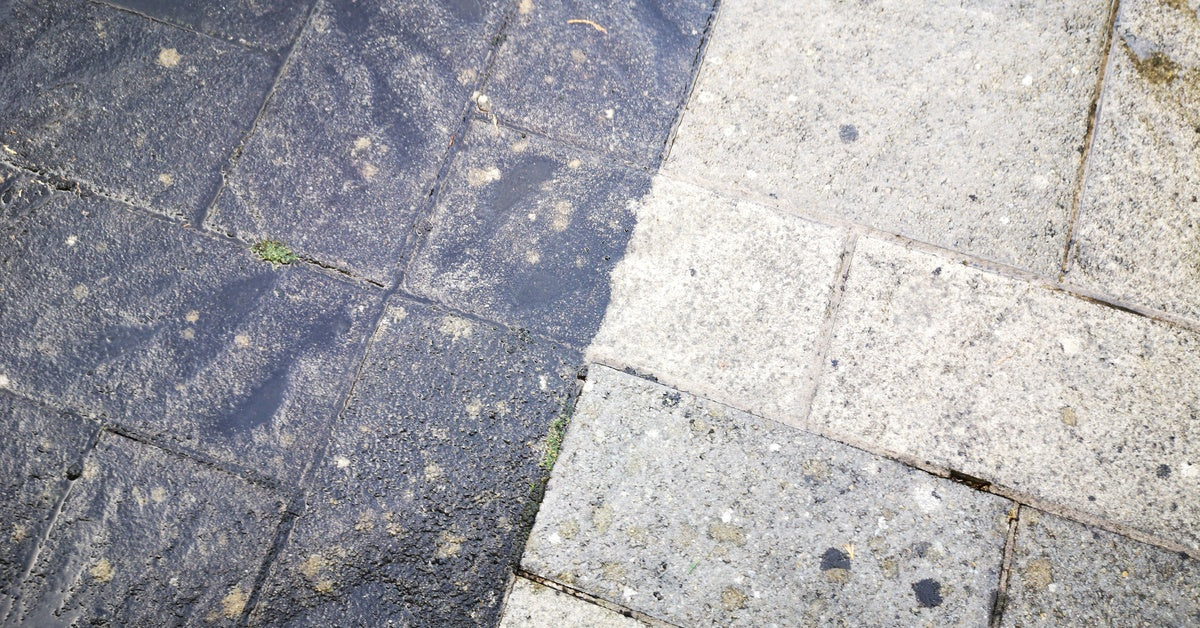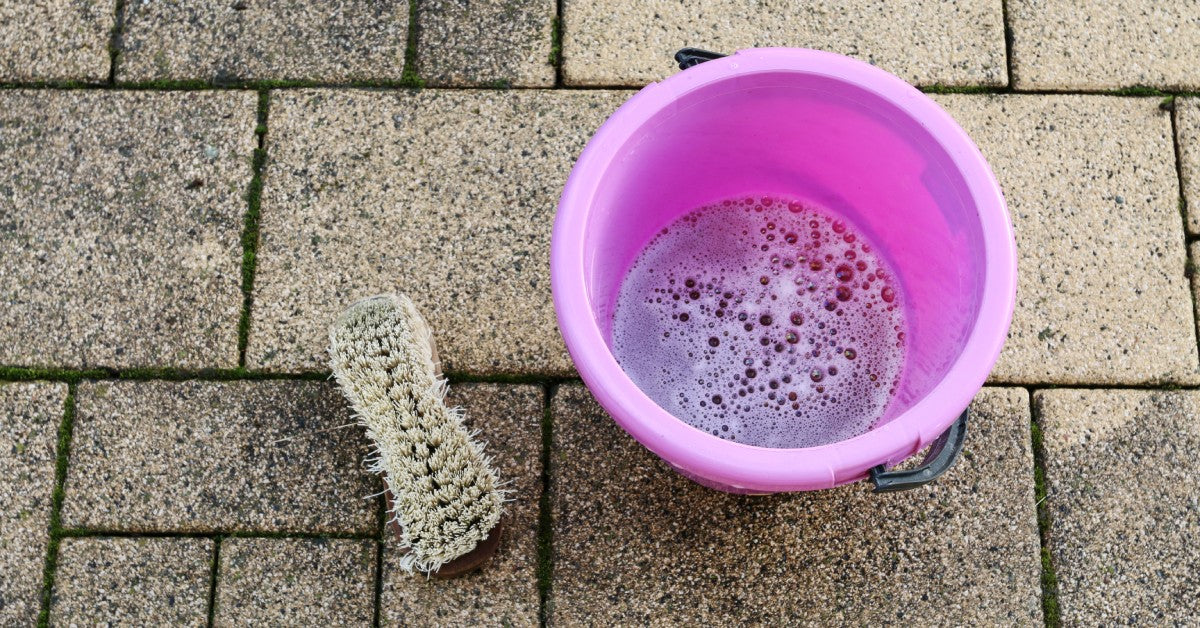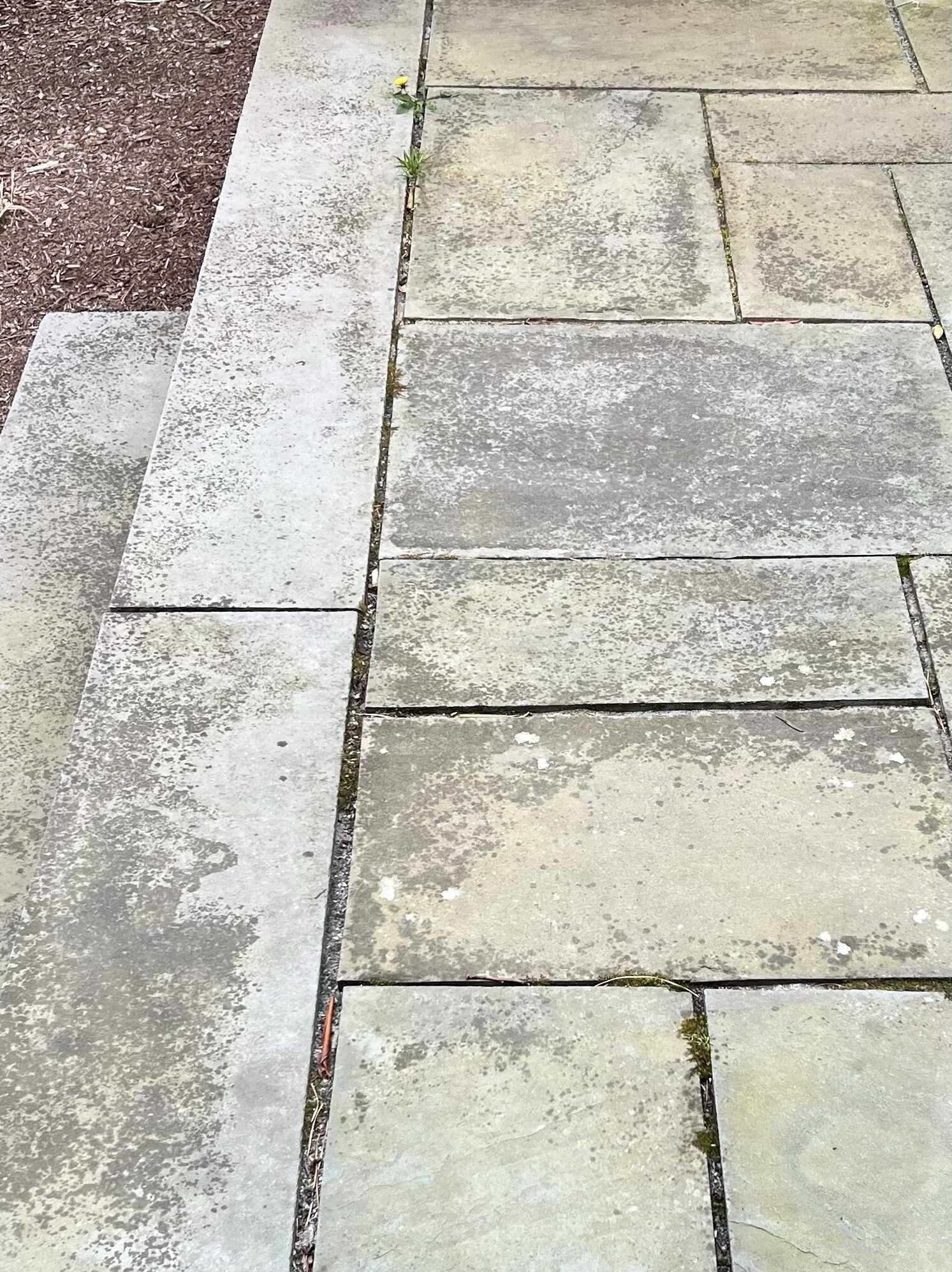Natural stone patios add beauty and durability to outdoor spaces, but over time, unsightly black spots can develop on the surface. These dark blemishes can turn an elegant patio into an eyesore.
Understanding why these spots form is key to finding effective treatments and prevention strategies. This guide covers the main causes of black spots on natural stone patios, prevention tips, and safe removal methods to protect your surfaces and restore their appearance.
Noticing Black Spots on Your Patio?
Black spots on natural stone often appear as small dark patches that expand over time. They start as tiny specks but can grow into larger irregular shapes, darker than the natural stone color and sometimes slightly raised or textured.
These spots commonly form in areas with poor drainage, little sunlight, or frequent moisture, such as joints, corners where debris collects, or under stationary furniture. The black discoloration can range from charcoal gray to deep black, depending on the growth and natural stone’s color.
Detecting these spots early makes cleaning easier and prevents them from spreading across your patio. Look for irregular patterns in your natural stone and small, black or grey spotting. This helps homeowners spot problem areas before they require intensive cleaning.
The Biggest Cause: Black Lichen
Black lichen is the most common cause of dark spots on natural stone patios across different climates. These organisms, made up of fungi and algae, form persistent, dark growths on stone surfaces. They thrive in outdoor areas where moisture and nutrients from dust and debris collect on porous stone.
The fungal part of lichen penetrates the stone, making it harder to remove than surface-level contaminants. Lichen prefers slightly alkaline conditions, which many natural stones provide, creating ideal environments for growth. It can go dormant during dry periods and quickly resume growth when moisture returns, which makes it even harder to detect and remove.
Black lichen is especially problematic because it strongly adheres to stone and releases acids that can etch the surface. Its dark pigmentation creates the black spots homeowners find unsightly, and its stubborn nature makes casual cleaning largely ineffective.
Other Causes of Spotting on Patios
Patio spotting can result from various factors beyond or in addition to black lichen. Understanding the root causes is essential to properly address and prevent future discoloration or damage.
Algae and Moss Growth

Algae and moss also cause discoloration on natural stone patios and can appear as dark spots in certain conditions. Algae forms thin, slippery films that are green when active but darken to brown or black when they dry out.
Moss typically appears as small, cushion-like patches that start green but may darken over time. Unlike lichen, moss doesn’t penetrate deeply into stone, making it easier to remove with the right techniques.
Mold and Mildew
Mold and mildew can develop on natural stone patios when organic matter accumulates and moisture levels remain consistently high. These fungi appear as dark spots or patches that may have fuzzy or powdery textures distinguishing them from lichen growth. Mildew typically appears as flat, dark stains, while mold can create raised, textured growths with various colorations including black, brown, or gray.
Poor drainage conditions, excessive shade, and accumulated organic debris create ideal environments for mold and mildew development. These organisms feed on organic matter that settles on stone surfaces over time.
Organic Debris
Decomposing organic matter can create persistent black stains on natural stone surfaces even after removing the original debris. Fallen leaves, flower petals, fruits, and other plant materials contain tannins and organic compounds that can permanently stain porous stone materials. These stains often appear as dark outlines matching the shape of the original debris.
How to Prevent Black Spots on Natural Stone
The best way to deal with black spot stains is to prevent them in the first place. Preventing black spot stains requires a combination of proper maintenance, protective measures, and timely cleaning techniques.
Regular Cleaning
Consistent cleaning prevents the buildup of organic matter and moisture that lead to some spotting on natural stone patios. Weekly sweeping removes debris and dust before they decompose and cause stains or encourage biological growth. Using a specialty black spot cleaner, as we’ll outline below, can also help prevent common lichen-related spotting.
Promptly removing fallen leaves, food spills, and pet waste prevents stains and reduces nutrients for unwanted growth. Regular maintenance also helps detect problems early when solutions are simpler and more effective.
Proper Drainage

Good drainage prevents water buildup that encourages biological growth on stone surfaces. Proper slopes, drainage channels, or permeable joints allow water to flow away instead of pooling in low spots. Fixing drainage issues reduces moisture that supports lichen, algae, moss, and mold.
Improving air circulation helps surfaces dry faster after rain or cleaning. Trimming vegetation, moving outdoor furniture occasionally, and ensuring proper spacing between structures promote airflow and discourage growth.
Removing Black Spots from Natural Stone
Black spots on natural stone are often caused by lichen or mildew and can be tough to remove. The right techniques and cleaners can restore the stone’s natural look without damage.
Avoid Pressure Washing
Pressure washing can harm natural stone and fail to remove deep-seated biological growth like lichen. High-pressure water can erode softer stones, widen cracks, or push water deeper into the stone, leading to freeze-thaw damage. It won’t be enough to eliminate the organisms causing black spots, which allows them to return and causes these damages in the process.
Forceful water can drive contaminants deeper into porous stone, making future removal harder. Many stones require gentler cleaning methods that preserve the material while addressing the root causes of discoloration.
Specialized Cleaning Solutions
Professional-grade cleaning solutions designed specifically for natural stone surfaces provide the most effective approach for removing black spots while protecting your investment. These specialized products target biological growth at its source, breaking down the organisms and their adherence to stone surfaces without causing damage to the material itself.
Patio Black Spot Removal Inc. offers advanced patio cleaner products formulated specifically for natural stone applications. Our formulations provide safe and effective treatment of various types of discoloration. These products provide longer-lasting results compared to general-purpose cleaners by addressing both surface contamination and embedded organisms that cause recurring problems.
Maintain Your Natural Stone Investment
Black spots on natural stone patios are often caused by biological and environmental factors, with black lichen being the most common and stubborn culprit. Understanding these causes helps homeowners prevent and treat discoloration while preserving their stone surfaces.
Regular maintenance, good drainage, and prompt action can stop minor issues from becoming costly repairs. For existing black spots, specialized cleaning solutions for natural stone offer safe and effective treatment.
Contact Patio Black Spot Removal Inc. to learn more about professional cleaning solutions that restore your patio’s beauty and protect your investment.



